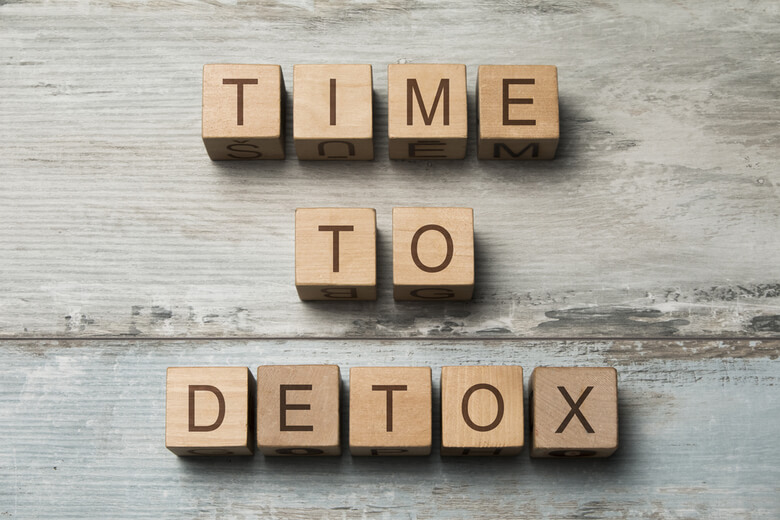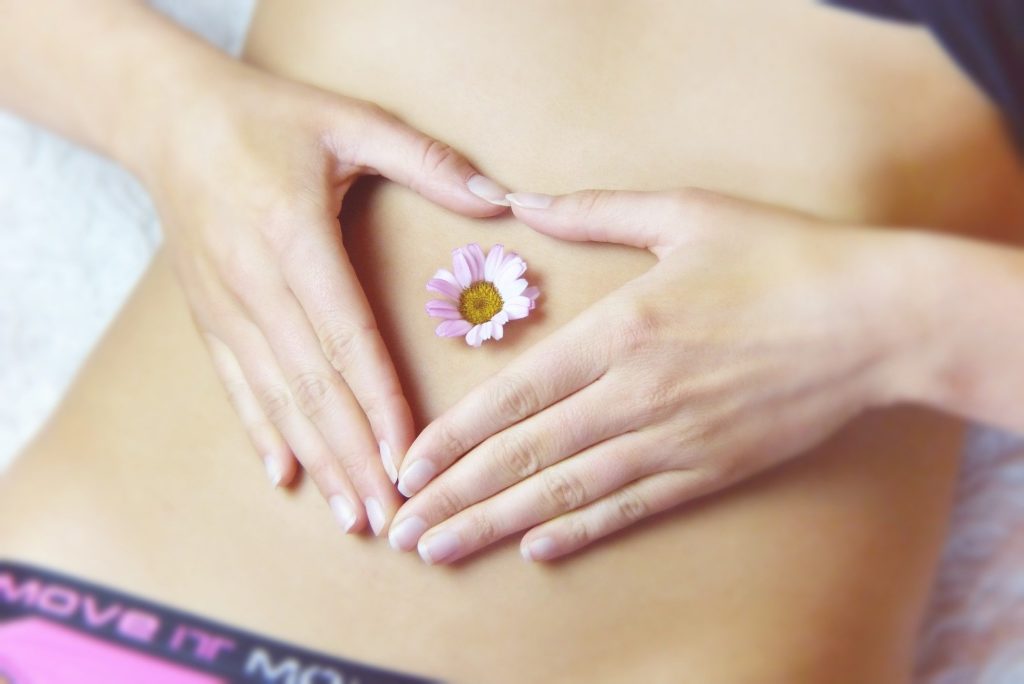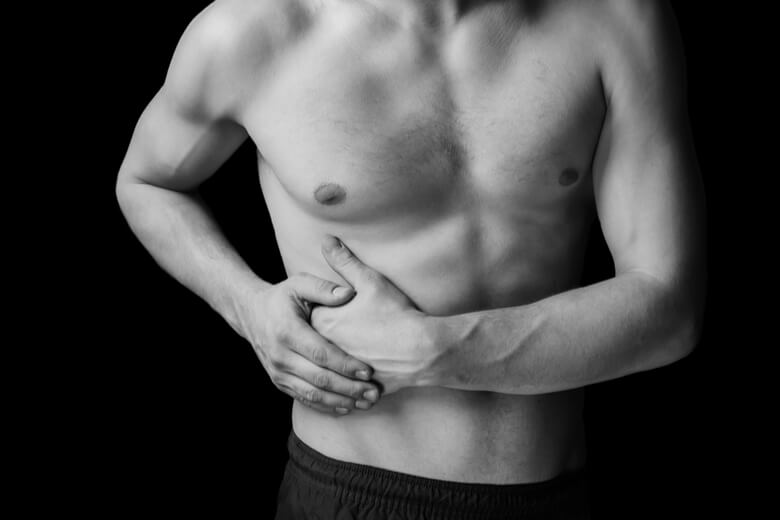The liver is the largest organ in the human body, therefore it is a target organ of the detox.Below you will find everything you need to know about the liver detox.
The liver: The largest organ of the human body
The liver is the largest organ of the human body. It has two lobes.
The large right lobe is located on the right side of the upper abdomen, under the dome of the diaphragm, extending deep into the rib cage.The smaller left lobe can be felt at the tip of the sternum, just below the costal arch.
In the middle of them is the gallbladder which is a pear-shaped pouch of about ten centimetres that stores the bile produced by the liver while waiting to fulfil its digestive function.
The lobes of the liver are composed of about 45 million hepatic lobules, hexagonal in shape, which give the liver its granular appearance. Each globule is itself made up of liver cells, called hepatocytes, nearly 300 billion for the whole liver!
The liver is supplied with a massive amount of oxygenated blood via the hepatic artery, which comes from the branching of the aorta.
Another large blood supply comes from the portal vein, which transmits blood from the small intestine, the spleen and the large intestine to the liver.
This blood contains the nutrients from digestive catabolism but also the resulting toxic waste products.
The hepatic vein takes care of the toxic waste excreted by the liver, hence the interest of theDETOX which stimulates this necessary process of elimination if we do not want the liver to be congested, paralysing its good functioning.
Are you hepatic?
The symptoms of hepatic insufficiency (lazinesshepatic) are multiple. An oppressive feeling of fullness occurs in the right abdominal region at the end of meals. There is a feeling of fatigue after eating, heaviness, a desire to sleep.
The liver patient suffers from chronic constipation.
His tongue is loaded, his mouth is pasty.The whites of the eyes and the skin of the face are yellow.
Pruritus develops, very unpleasant itching of the skin.
The morning wake-up of the hepatic is difficult, the neck is heavy, the eyelids are swollen, with frequent joint pains.
The morning urine is very concentrated and smelly.
If you recognize yourself in this list of symptoms, there is no doubt thatDETOX concerns you.
Hepatic steatosis: a major public health problem
Without wishing to be provocative, the medical term "hepatic steatosis" refers to a condition that can be described as "fatty liver"!
To obtain foie gras, farmers force-feed the animals twice a day: they insert a tube into the digestive tract of the geese or ducks and then inject a large quantity of cereal slurry into this tube. In humans, force-feeding is different, more devious, slower, but just as harmful. The permanent overconsumption of saturated fats of animal origin and fast sugars leads to a real hepatic congestion: fat accumulates in the liver.
This condition is steatosis, about which the Ministry of Health states that it will be a major public health problem in France in the coming decades.
Indeed, steatosis leads to multiple dysfunctions: obesity, diabetes, high blood pressure, hypercholesterolemia, increased risk of cardiovascular accident ...
Fortunately, hepatic steatosis is reversible.To reverse the process, it is necessary to attack the causes of the disease, this "fatty liver" source of discomfort by following an appropriate diet, as digestible as possible, low in fats, and by making very regularly a DETOX purge, the ideal being 4 times per year, at each change of season.
The Liver: A purification station
The liver can be considered as an authentic purification station.
Blood filtration
In the hepatic lobules, which are highly vascularised (the red colour of the liver bears witness to this), blood circulates abundantly in order to allow the extraction of toxic elements which would poison the organism if the liver could not fulfil its function as a filter.
The air we breathe and the food we eat contain a lot of toxic products that the liver is responsible for filtering in order to eliminate them.
Not to mention the waste products of digestive catabolism, those resulting from the degradation of dead cells transformed by macrophages and those from pharmacokinetics, the final stage of which produces elements that must be eliminated by natural means.
Cytochromes P451
It is in the liver that the main detoxification mechanism of our body is triggered.The liver synthesises enzymes that enable this DETOX: the cytochromes P450.
Cytochromes P450 are a highly effective depolluting tool for protecting the body against the harmful effects of toxic products, as shown by a multidisciplinary French team (CNRS, INSERM, Faculties of Medicine and Pharmacy) whose work has been published in the Annals of Clinical Biology.
A doctoral thesis describes the action of these cytochromes P450.
Here is an extract that speaks for itself:
"In the space of half a century, the cytochromes P450 have become emblems of the scientific community of biologists, so intense is the infatuation they arouse.This large family of monooxygenase haemoprotein enzymes is responsible for the metabolisation and detoxification of exogenous xenobiotic compounds."
We have underlined the word detoxification whose contraction DETOXis today so popular, and rightly so, as it is necessary to emphasise how DETOXis the fundamental step in the recovery of health, whatever the problem affecting the organism.
Precious bile
The primary function of the liver is to secrete bile, which enables the digestion of fatty substances.The emptying of the stomach begins about 3/4 hour after the first food is swallowed.The food chyme is forced into the pylorus and emerges in liquid form, with proteins and carbohydrates in solution and lipids (fats) floating on the surface like eyes in a fat broth.
In the duodenum, this emergence causes a contraction, a back and forth movement that results in the production of secretin and cholecystokinin triggering the discharge of jets of bile and pancreatic juice.The bile then acts as a detergent, emulsifying (solubilising) the fats that are floating in the food chyme.
Every day, our liver secretes about 1 litre of bile per day!
It is a viscous, bitter liquid.Made by the hepatocytes, bile is stored in the gallbladder between two digestive episodes.It is the bile duct that carries it to the duodenum.
Any action ofDETOX the liver is beneficial, regulating dysfunctions that may impede bile secretion.
Bad stones!
Gallstones are concretions of stony structure that develop in the gallbladder, obstructing the bile duct, preventing the flow of bile.These stones form when the bile contains too much cholesterol and not enough bile salts.
This results in what is known as "biliary lithiasis", manifested by right intercostal pain caused by the efforts that must be made, with each digestion, to excrete bile despite the obstruction of the stones.Biliary lithiasis results in violent contractions, colic.In addition, intestinal transit is slowed down.
These stones develop in clusters or remain isolated.Several thousand (!) can be found during a cholecystectomy, an operation which consists of opening the gallbladder to remove the stones.
It is better to avoid the operation by following a cholesterol-lowering diet, low in fats, supplemented with active ingredients favouring the DETOX of the bile ducts (liver & gallbladder).
Alcohol is the enemy of the liver
People who consume alcohol in excess and permanently should know: it is the enemy of their liver, whatever the alcohol, beer or wine, aperitif or digestive ...
Alcoholism (since this toxic addiction must be called by its name) leads to liver degeneration, cirrhosis.
Cirrhosis is a form of fibrosis.The hepatic "overwork" caused by the repeated aggression of alcohol against the liver causes lesions that leave real scars and impede the free circulation of blood in the organ.
The structure of the liver is disrupted.It thickens, becomes fibrous and hardens.This fibrous neo-tissue explains the qualification of cirrhosis: fibrosis.Stopping drinking can stop this process.
Alcohol withdrawal is an absolute necessity in the case of cirrhosis.
And this withdrawal will be all the more effective if a concomitant DETOX is programmed, for as long as necessary to relieve the liver.
Support your liver by facilitating your digestion
- Eat in a calm, relaxed atmosphere, without reading or watching television.
- Do not wear tight clothing at the table.
- Eat at regular times and do not skip meals.
- Leave at least 4 hours between meals.
- Don't snack between meals to avoid digestive overload and weight gain.
- Lighten your evening meal to sleep better.
- Eat slowly, chew your food well.
- Chew starchy foods to avoid flatulence, saliva initiates digestion.
- Drink moderately during meals, so as not to dilute the food bowl too much.
- Don't drink ice water, it hinders digestion.
- Don't drink aperitifs or digestives, but do drink a glass of wine for its high polyphenol content.
- Preferably eat fresh, natural, organically grown products.
- Limit your consumption of manufactured and refined products.
- Eat foods rich in fibre, fruits, vegetables, whole grains.
- Avoid fast sugars and animal fats, cold cuts and sauces.
- Diversify your proteins, eat more fish, vegetable proteins.
- Eat moderately acidic ingredients, vinegar, mustard, pickles.
- Avoid flavourings that irritate the digestive tract: pepper, hot pepper.
- Take into account food compatibility, seek advice from a nutritionist.
- Regulate your acid-base balance.
- Do not end your meal with ice cream, it short-circuits digestion.
- Don't drink coffee at the end of your meal, drink a digestive herbal tea.
- Take hepato-stimulant cures:
- And 4 times a year a DETOX purge favouring the hepatic decongestion.
Bibliography
Cytochromes P450: xenobiotic metabolism, regulation and clinical importance.
Y Guéguen, K Mouzat, L Ferrari, E Tissandie, JMA Lobaccaro, A-M Batt, F
Paquet,
P Voisin, J Aigueperse, P Gourmelon, M Souidi.
Annales de biologie clinique, 2006 Nov-Dec;64(6):535-48.
Relationships, structure, function in the CYTOCHROMES P450 superfamily.
Doctoral thesis defended by Thiën-Ân Nguyên.
University of Paris VII, 29 October 2007.





